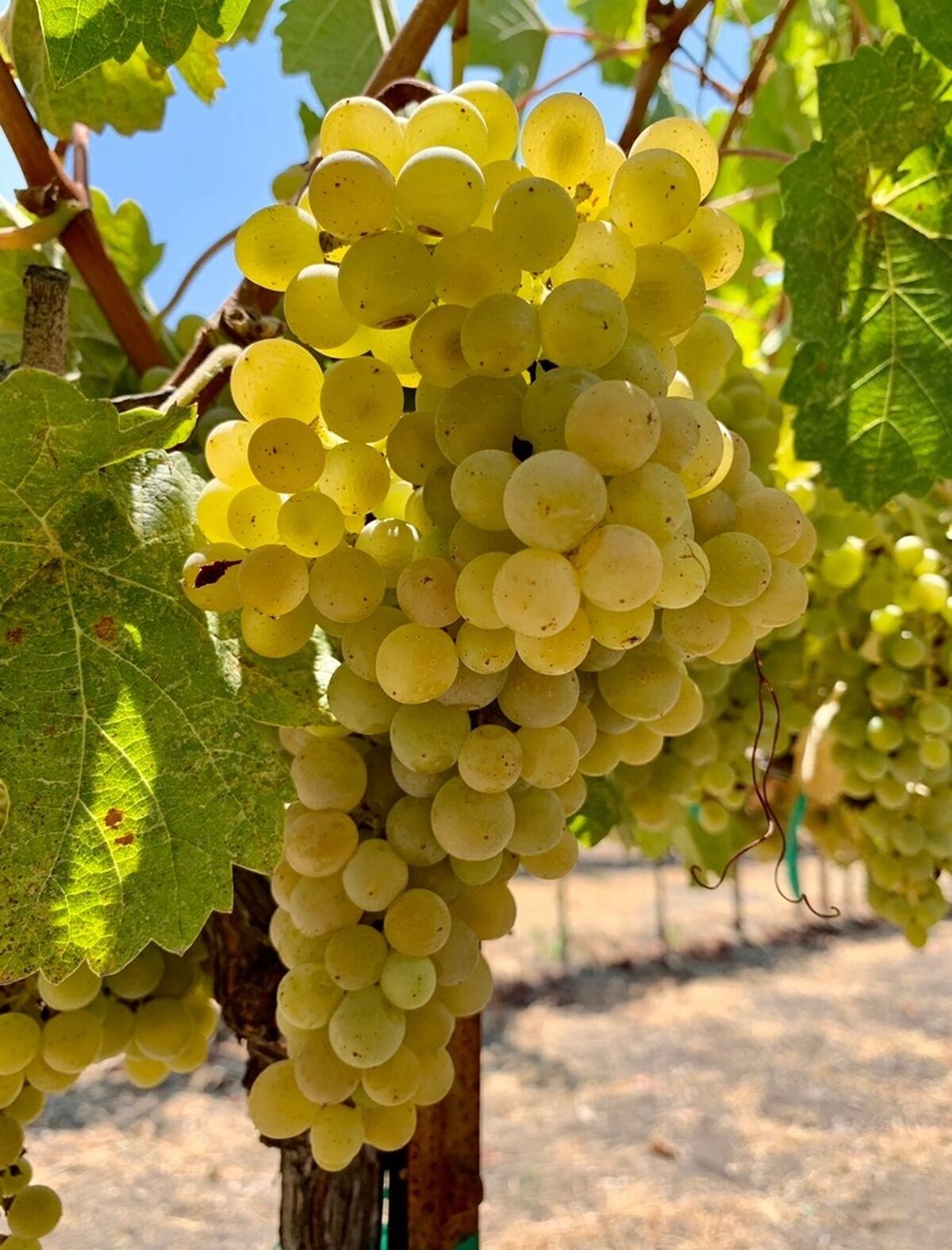Bourboulenc
Bourboulenc is an ancient white grape from the region surrounding Avignon, valued in France for its vigor, floral character and ability to maintain acids in warm climate. Our two-thirds of an acre, planted in 2016, was the first acreage outside its French homeland. Bourboulenc's bright acids, rich texture, and nutty finish make it an appealing varietal bottling and we have found it valuable in our blends as well.

Bourboulenc Today
Bourboulenc is the fourth-most planted white grape in the Chateauneuf-du-Pape appellation (after Grenache Blanc, Clairette, and Roussanne) at nearly 85 acres, making it roughly 1% of total plantings and 15% of white acreage. As of 2016, there were about 1,230 acres planted worldwide, all of it in France except the handful of acres that were planted from our clones here in California.
Bourboulenc is pronounced boor-boo-lonk. Like nearly all French words, the syllables are emphasized equally.
Early History
According to Jancis Robinson, the grape Bourboulenc first appears in the historical record in 1515 in a description of a vineyard near Cavaillon, an ancient village about ten miles south-east of Avignon. It appears to have been named after another vineyard near Avignon that was known as Barbolenquiera. As Bourboulenc, it is still mostly planted in the regions surrounding Avignon, including Costières de Nîmes, Tavel, Cassis, Bandol, Languedoc, Corbières, Minervois, and (of course) Châteauneuf-du-Pape.
Bourboulenc's acreage is down by some 60% from its peak of near 3000 acres around 1970, a victim of a fashion for richer wines in the 1980s and 1990s and a shift in focus from white to rosé in the 2000s and early 2010s. But its ability to retain acid in warm climates is leading to a resurgence in interest and the Perrin report an uptick in plantings over the last decade.
Bourboulenc at Tablas Creek
In our first round of grape imports, which we brought into quarantine in 1989 and were released in 1992, we focused on the main grapes at Beaucastel: Mourvedre, Syrah, Grenache, Counoise, Roussanne, Grenache Blanc, Marsanne, and Viognier. Shortly after, we brought in Picpoul Blanc.
By 2003, we'd been sufficiently convinced that the more obscure Rhone grapes could shine here that we decided to import the complete Beaucastel collection, which meant another seven grapes. Terret Noir and Clairette Blanche were the first two to be released to us, in 2009. Picardan was next in 2012. Cinsaut, Bourboulenc, and Vaccarese were released in 2015, propagated, and then planted at Tablas in 2017. Muscardin, the seventh and final of those grapes, was released to us in 2017.
We chose a small (0.66 acre) block with a west-facing slope at the far western edge of Tablas Creek for Bourboulenc, and harvested our first small crop in 2019. In 2020 we grafted another half-acre of Bourboulenc onto some Grenache Blanc trunks.
Bourboulenc in the Vineyard & Cellar
Bourboulenc vines are extremely vigorous. We have to shoot thin more aggressively in our Bourboulenc block than in any other grape, in order to keep it from turning into a jungle each summer. Bourboulenc's berries are relatively large, and its clusters loose, which makes it resistant to rot. In France, it is known as drought-tolerant and prized for its ability to retain good acids while still achieving above-average body, but can be a risk because it is late-ripening. We haven't found that to be true here. In 2019 (our first harvest) we picked 2.15 tons of Bourboulenc at 20° Brix (roughly 12.4% potential alcohol), and a pH of 3.38. In 2020 we harvested 3.05 tons at 19° Brix and a pH of 3.38. Both years we picked in September, at roughly the one-third mark of harvest. That puts the grape in sync with Marsanne and Grenache Blanc. The sugars were among the lower levels that we picked, and the acids toward the lower pH (higher acid) end.
In 2019, and to a lesser extent in 2020, we noticed a distinctive orange color in the Bourboulenc juice as it came out of the press. Much of that color dropped out during fermentation, but it remained a darker gold than most of our white wines. This is not mentioned in the literature anywhere that we've been able to find, nor is it a phenomenon that the Perrins have seen at Beaucastel. Since 2020 we have left more canopy on the vines to shade the clusters better, and seen more classic colors.
In the cellar we have fermented Bourboulenc in both stainless steel tanks and neutral 600-gallon foudres, and found that both produce good results.
As we do with our new varieties, we bottled our Bourboulenc on its own in 2019, its first year of production. But we were surprised that the very next year it showed well enough for us to include it in our 2020 Esprit de Tablas Blanc, where its brightness provides counterpoint to the wine's Roussanne base. Since then, we have both included it in our flagship white blend and bottled it on its own most years.
Aromas and Flavors
Bourboulenc shows a nose of lychee and wet rocks, lightly floral, with an unusual and appealing fresh almond note. On the palate, it is richly textured and softly mineral, with pineapple and Seville orange fruit and a little mintiness, pretty and delicate and lovely. We have no idea how it will age, but think that its rich texture and its acids should give it the capacity to age at least moderately long in bottle. We will know more in coming years.
This article originally appeared in one of our newsletters. Each newsletter, we spotlight the history and characteristics of one of our Rhone varietals. You can sign up for our mailing list.
You can view a one-minute video summary of Bourboulenc on our YouTube page.
You can go back to the summaries of the different Rhône grape varietals.